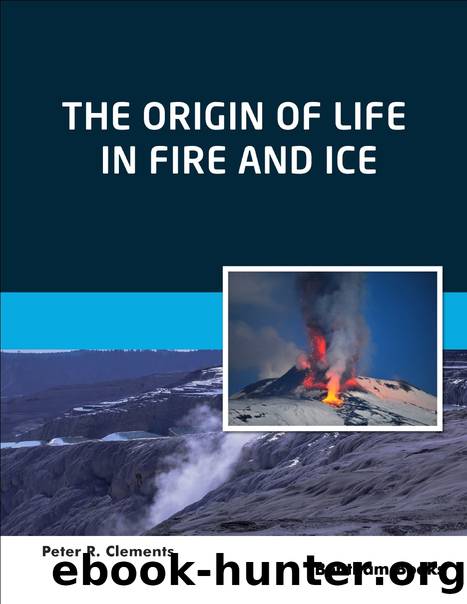The Origin of Life in Fire and Ice by Clements Peter R.;

Author:Clements, Peter R.;
Language: eng
Format: epub
Publisher: Bentham Science Publishers
Published: 2022-01-05T00:00:00+00:00
Self-reproduction by Limited Peptides
Stuart Kauffman (The Origins of Order, 1986) [28] showed that peptides that are randomly allowed to form from a mixture of amino acids will generate some peptides with catalytic activity. Initially the only ones that increase in the amount in this mixture are peptides that catalyse their own formation. However, in our primitive vesicle, this is not a perfect copying environment and âmistakesâ will occur; nor is it a pure solution of only amino acids, so other molecular interactions are almost certain to occur, particularly hydrophobic associations which offer mutual protection against decomposition by agents such as UV irradiation. Subsequent mistakes/mutations/changes can be readily envisaged in these self-catalysing peptides to allow them to catalyse other reactions such as bond breaking and bond making to make other peptides, or bonds between other components like sugars, that catalyse new reactions and make new peptides and other compounds. Associations with other molecules such as purines and pyrimidines, metal ions and mineral salts would have influenced the products formed in this environment. While complex associations may have occurred, the process of enriching a population of particular peptides will have had the effect of partially purifying that peptide in the mixture.
To quote Kauffman in reference to the randomly forming peptides:
âThis leads to the emergence of self-replicating systems as a self-organizing collective property of critically complex protein systems in a prebiotic evolutionâ.
So peptides could have developed with specific self-replicating activities. Indeed this is the only way that we can envisage single peptides increasing in amount from within a mixture of random peptides. The âenzymeâ activity displayed by the peptide would involve peptide formation and as âmutationsâ occur in this highly impure and complex mixture, the catalytic activity could transform into catalysing the formation of other bonds. The smallest known enzyme of the current biochemistry is a peroxidase of 60 amino acids in length. Primitive enzymes may have been shorter. The peptides in development here are the ones referred to as ancestral peptides which have specific roles such as binding nucleotides.
Peptides with activity consist of associations with other components such as nucleosides, e.g., adenine, and sugars, which, by virtue of their aromatic structures provide protection against UV damage and free radical damage. Vesicles containing these peptides fuse with other vesicles containing perhaps different peptides or other complementary compounds such as polyphosphate. Polyphosphate and pyrophosphate (diphosphate) both release energy when hydrolysed and could help to provide energy for the vesicles. Other iron sulphur reactions could be part of the mix [21] and eventual efficiency improvements by covalent linkages lead to proto-enzymes from both peptide and nucleoside origins. While peptide based enzymes would initially be limited, there could be a supporting reaction driving the formation of particular bonds such as sugar-purine bonding, particularly ribose, supported by polyphosphate energetics. Eventually, the phosphate becomes incorporated because this is more efficient and hence you have the development of the first nucleotide.
A crucial step in the formation of peptides is that some with catalytic activity are produced. Catalytic peptides can plausibly lead to the formation of nucleotides.
Download
This site does not store any files on its server. We only index and link to content provided by other sites. Please contact the content providers to delete copyright contents if any and email us, we'll remove relevant links or contents immediately.
Sapiens: A Brief History of Humankind by Yuval Noah Harari(14244)
Sapiens by Yuval Noah Harari(5293)
Pale Blue Dot by Carl Sagan(4907)
Homo Deus: A Brief History of Tomorrow by Yuval Noah Harari(4820)
Livewired by David Eagleman(3682)
Origin Story: A Big History of Everything by David Christian(3648)
Brief Answers to the Big Questions by Stephen Hawking(3369)
Inferior by Angela Saini(3276)
Origin Story by David Christian(3145)
Signature in the Cell: DNA and the Evidence for Intelligent Design by Stephen C. Meyer(3070)
The Gene: An Intimate History by Siddhartha Mukherjee(3046)
The Evolution of Beauty by Richard O. Prum(2936)
Aliens by Jim Al-Khalili(2785)
How The Mind Works by Steven Pinker(2728)
A Short History of Nearly Everything by Bryson Bill(2627)
Sex at Dawn: The Prehistoric Origins of Modern Sexuality by Ryan Christopher(2481)
From Bacteria to Bach and Back by Daniel C. Dennett(2441)
Endless Forms Most Beautiful by Sean B. Carroll(2429)
Who We Are and How We Got Here by David Reich(2397)
